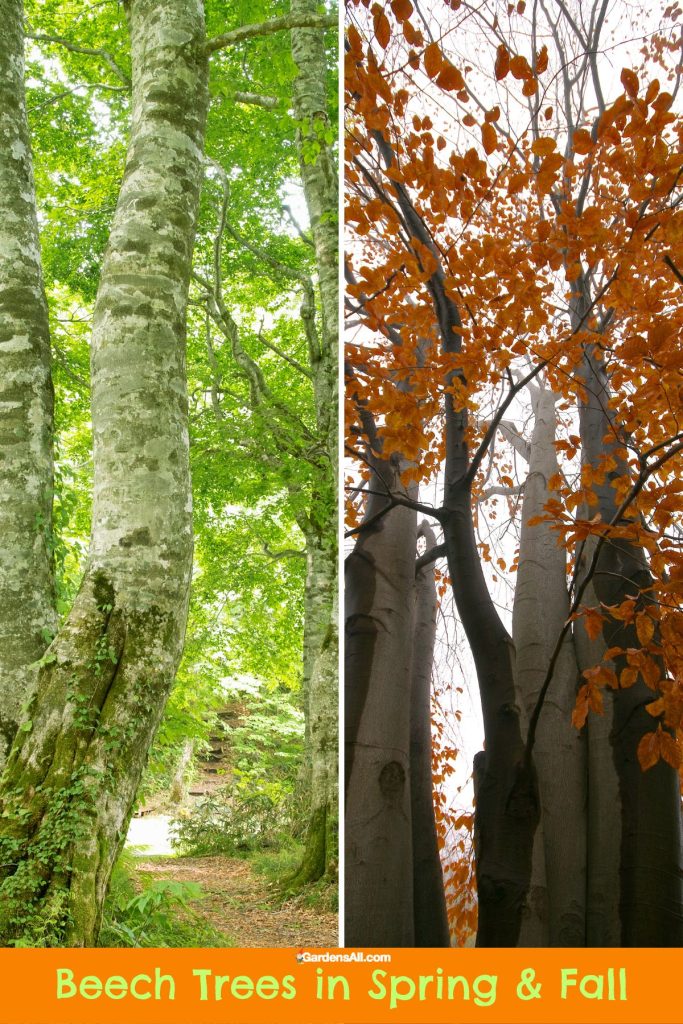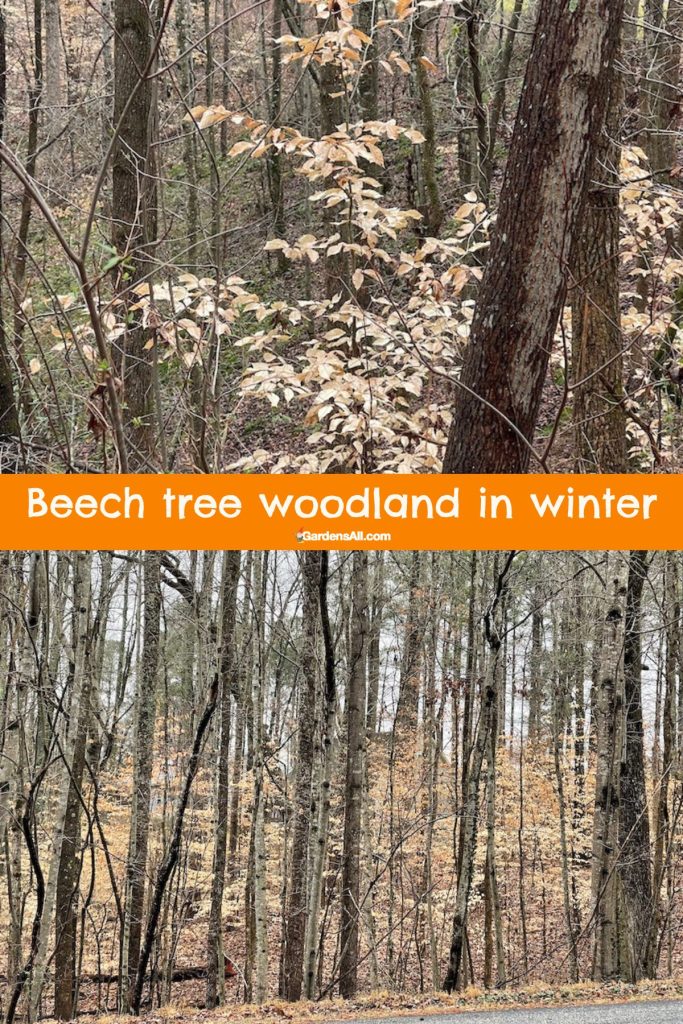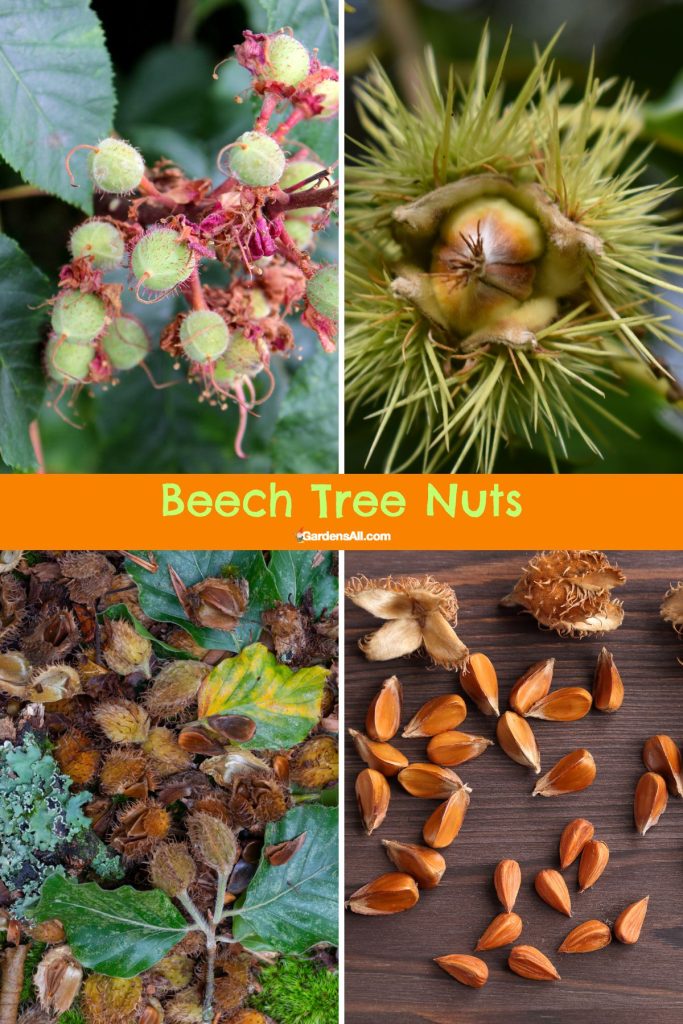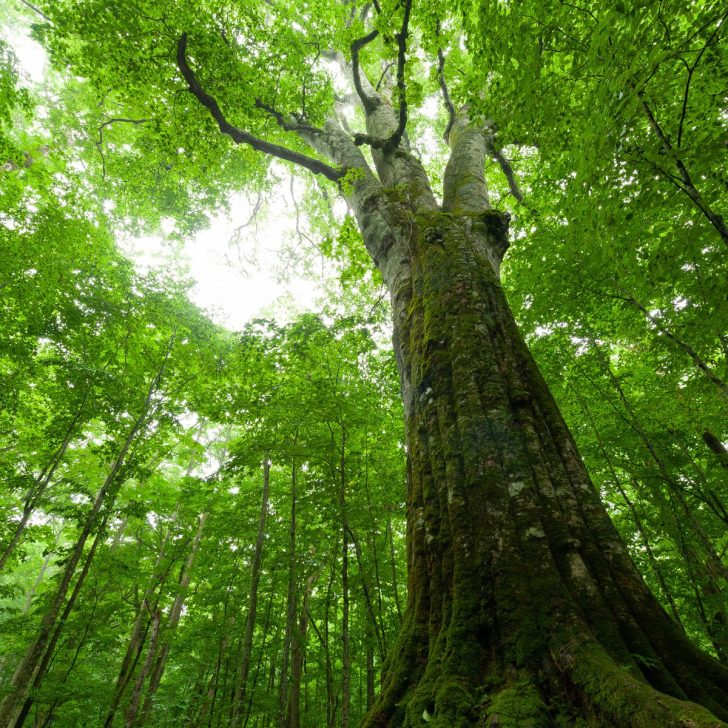For every plant I research, I want to know what treasures it holds beyond common knowledge. Same for trees. So I began this article by asking these questions about one of our favorite trees around us: What are the beech tree uses and benefits, and is it edible and/or medicinal? We’ll cover that all in this article.
My inquiry started because we have many beautiful American beech trees all around us in our home in the woods. The biggest one we calculated to be approximately 260 years old!
I love how beech trees retain their leaves throughout the winter, providing warm golden-tan colored highlights amidst a wintry backdrop of gray tree trunks and branches. Seeing them, I also wondered, “Why do beech trees keep their leaves all winter?
But first, a very brief skip through the beech tree origin story.

Beech Tree Origin
The Beech tree, a majestic and versatile species, belongs to the Fagus genus and is well-regarded for its beauty, durability, and wide array of uses. Found across Europe, Asia, and North America, Beech trees have adapted to various climates and conditions, making them a staple in both natural forests and cultivated landscapes.
In this article we explore the multifaceted uses and benefits of Beech trees, from ecology and economy to edible and medicinal benefits, we hope you’ll find something here of interest to you.

Winter Leaf Marcescence… What Is It?
An intriguing aspect of some Beech trees, particularly noticeable in the colder months, is a phenomenon known as “winter leaf marcescence.” This term refers to the tree’s tendency to retain its dead leaves throughout the winter, rather than shedding them in the fall like many other deciduous trees.
Scientists don’t really know what causes beech trees to retain their leaves in winter, however several hypotheses suggest it may provide certain advantages.

Why Do Beech Trees Retain Their Leaves in Winter?
One theory on why the beech tree retains its leaves is that it could offer physical protection for the tree’s buds against winter cold and help to deter foraging by deer and other herbivores.
Additionally, holding onto its leaves until spring could possibly allow the leaves to drop and decompose at the best timing for the beech tree growing cycle.
Painting the Woods With Blond Highlights
Marcescence also adds an aesthetic element to the winter landscape. Beech tree leaves decorate winter woodland scenes with golden tan colored leaves reminiscent of blonde highlights blowing in the wind against the barren winter backdrop.

BEECH TREE USES AND BENEFITS
Ecological Contributions
This term typically refers to the role an organism or species plays within its ecosystem. It focuses on the interactions and relationships between species and their environment. For the American Beech tree, ecological contributions might include:
- Providing habitat and food for wildlife.
- Contributing to the diversity and structure of forest ecosystems.
- Beech trees are a climax species, meaning their presence indicates a mature and stable ecosystem.
These contributions are about the specific functions and roles the species plays in maintaining the balance and health of ecosystems.
Environmental Benefits
These environmental benefits are mostly applicable to all trees, and include:
- Carbon sequestration and climate regulation.
- Soil stabilization and improvement.
- Water cycle regulation and purification through the process known as “transpiration“.
These benefits are more about the positive effects on environmental systems at large, including impacts on air quality, climate, and soil health, which can extend beyond the immediate ecosystem.
Edible Uses
- Beech Nuts: While not as commonly harvested for human consumption today, beech nuts are edible and nutritious, rich in fats, proteins, and carbohydrates. Historically, they were used by Indigenous peoples and early European settlers as a food source. They can be roasted and eaten or used as an ingredient in various dishes.
- Beech Leaves: Young Beech leaves are tender and edible, often described as having a mild, sweet taste. They can be used fresh in salads or as a garnish. The leaves are most palatable in the spring when they are young and soft.

Landscape and Aesthetic Value
American Beech trees are appreciated for their majestic appearance and smooth, silver-gray bark. They can be a striking addition to large landscapes, parks, and gardens, offering shade and visual interest throughout the seasons. The tree’s dense foliage turns a golden bronze in the fall, adding seasonal beauty.
Health and Medicinal Benefits of Beech Trees
Various species within the Fagus genus has an array of beneficial compounds found in its bark, leaves, and flowers/buds. These components contribute to the tree’s medicinal properties, supporting traditional and potential modern uses in herbal medicine and cosmetics.
The European beech, Fagus sylvatica, is the most studied and used of the Fagus genus, especially for the cosmetic industry uses. However, while there may be variables amongst varieties and growing environments, most beech trees of the Fagus spp. have similar properties.
BARK: Beech Tree Bark Uses and Benefits
- Anti-diabetic: Studies show potential for controlling blood sugar by through glucose absorption delay by inhibiting enzymes such as α-glucosidase.
- Anti-inflammatory: Some traditional practices have used beech bark in preparations aimed at reducing inflammation, although scientific studies supporting this use are limited.
- Antioxidant: The bark of the Fagus sylvatica (European beech) tree is rich in compounds that can act as natural antioxidants, help fight off microbes.
- Astringent Properties: The bark of the Beech tree has been traditionally used for its astringent qualities. Astringents help to tighten and dry tissue, making beech bark useful in folk remedies for treating minor wounds, cuts, and skin irritations.
The bark of the Beech tree is rich in tannins, compounds known for their astringent properties, which can help in tightening and drying out the tissue, making it beneficial for treating minor wounds and skin irritations. This astringency, coupled with potential anti-inflammatory compounds, may underlie the traditional uses of Beech bark in reducing inflammation and supporting skin health.[1]https://www.ncbi.nlm.nih.gov/pmc/articles/PMC6769934/

LEAVES: Beech Tree Leaves Uses and Benefits
- Skin Health: Beech tree leaves, when infused in water, have been used in traditional medicine for baths or washes intended to soothe skin conditions, owing to their mild astringent and potentially soothing properties.
- Tea for Detoxification and Immunity: Teas made from beech leaves have been consumed traditionally for their believed detoxifying effects and to bolster the immune system, though specific scientific evidence for these effects is sparse.
Beech leaves contain a variety of phytochemicals, including flavonoids and antioxidants, which protect against oxidative stress and may bolster the body’s immune response. The infusion of Beech leaves in teas and baths highlights traditional approaches to harnessing these benefits, aiming to leverage their mild astringent effects and support for the immune system through natural, plant-based remedies.

FLOWERS: Beech Tree Flowers and Buds (especially Fagus sylvatica bud extract)
- Antioxidant Properties: Beech bud extracts are noted for their antioxidant capacity, which can help protect the skin from oxidative stress and environmental pollutants.
- Homeopathic Remedies: In homeopathy, beech buds (especially from Fagus sylvatica) are used in tinctures and other preparations believed to support general vitality and well-being, though these uses are based on homeopathic principles rather than direct pharmacological action.
- Skin Rejuvenation and Hydration: Extracts from beech buds, particularly Fagus sylvatica, are celebrated in the cosmetic industry for promoting skin hydration, reducing the appearance of fine lines, and improving skin firmness.
The flowers and buds of the Beech tree, are rich in peptides and other growth factors, which have been shown to promote skin hydration, reduce the appearance of fine lines, and improve skin firmness. These cosmetic benefits are attributed to the buds’ ability to enhance cell oxygenation and metabolism, leading to healthier, more vibrant skin.
Additionally, the antioxidant properties of these extracts play a crucial role in protecting the skin from environmental stressors, making Beech bud extract a sought-after ingredient in the formulation of skincare products.
The popular Bach homeopathic remedies includes a beech flower essence touted as aiding in stress relief, positivity and tolerance.

NUTS: Beech Tree Nuts Uses and Benefits
The small, triangular nuts produced by the Beech tree are edible and highly nutritious. Known as “mast,” these nuts have been consumed by humans and wildlife alike for centuries.
Beech nuts are rich in fats, proteins, and carbohydrates, making them a substantial source of energy. They can be eaten raw, roasted, or ground into a flour to be used in cooking and baking. However, they should be consumed in moderation due to their high tannin content, which can be toxic in large amounts.
You may also enjoy our article on edible trees.

Woodworking and Craftsmanship
Despite the challenges in working with American Beech wood due to its tendency to warp and shrink, it is valued for certain applications where its hardness and strength are beneficial. This includes tool handles, woodenware (like spoons and bowls), and small furniture pieces. The wood’s fine grain and ability to take on a smooth finish make it suitable for detailed work.
Comparison Between European Beech and American Beech Trees
Here’s a comparison of the growth habits and lifespan from seed to adulthood for Fagus sylvatica (European Beech) and Fagus grandifolia (American Beech) presented in columns:
| Characteristic | Fagus sylvatica (European Beech) | Fagus grandifolia (American Beech) |
|---|---|---|
| Common Name | European Beech | American Beech |
| Geographic Range | Europe, from Sweden and Norway south to Italy, Spain, and Greece | Eastern North America, from Nova Scotia west to Wisconsin, south to Florida and Texas |
| Growth Rate | Slow to moderate | Slow |
| Mature Height | Up to 115-130 feet (35-40 meters) | Up to 70-80 feet (21-24 meters) |
| Lifespan | 150-200 years, can live up to 300-400 years | 200-300 years, can live up to 400 years |
| Seed Maturity Age | 30-40 years | 40 years |
| Shade Tolerance | High | High |
This comparison highlights the distinct characteristics of each species, from their geographic distribution and growth rates to their mature heights and lifespans. Both species exhibit high shade tolerance, a common trait within the Fagus genus, allowing them to thrive in forest understories and eventually reach the canopy as mature trees.
Cultural and Recreational Value
Beech trees are not only valued for their economic and environmental contributions but also for their aesthetic appeal. Their grand stature, smooth gray bark, and lush green foliage make them popular in parks, gardens, and landscapes.
In autumn, Beech leaves turn a vibrant shade of yellow or brown, adding to the scenic beauty of the surroundings. Furthermore, Beech forests are cherished spaces for recreational activities such as hiking, bird watching, and nature photography, offering people a chance to connect with nature.
Beech Tree Poem
Beech Trees Leaves in Winter
In winter’s grasp, where silence reigns
And frosty whispers fill the lanes,
The beech tree stands, a steadfast friend,
Its golden leaves refuse to end.
Against the gray, a warm tan hue,
A splash of color in the view,
The beech leaves dance, a gentle sway,
Brightening the shortest day.
In barren woods, they softly sing,
A testament to nature’s fling,
Where other trees have shed their dress,
Beech leaves in winter still impress.
So let us walk the woodland paths,
And find some solace in aftermaths,
For beech leaves, in their golden glow,
|Adorn the winter, and the snow.

I enjoy immersing in the research and lore on the wonderful world of plants and the many edible and medicinal uses. The more I discover some of the many magical properties of the plants all around us, the more appreciation I have for the mysteries and incredible gifts of the plant kingdom.
With prudence and knowledge, the edible and medicinal uses of the Beech tree highlight its versatility and the broader potential of trees in supporting human health and well-being. Whether as a source of food, natural medicine, or nutritional supplement, Beech trees offer valuable benefits beyond their ecological and economic importance.
I’m LeAura Alderson, a garden, herb and plant enthusiast with a passion for discovering the many edible and medicinal benefits of the plants all around us, including the weeds! I’m a writer, editor and media publisher for our family of websites.
While I was certified in fitness and life coaching, I am NOT a health practitioner. However, I’m a lifelong health enthusiast, with a keen interest in healthy, organic foods and making home remedies and the content we share is from our own experience and usage as well as that extracted from scientific research so that you can explore further on your own.
Always seek the advice and guidance of your health practitioners first and foremost.
As a family we’re steadily expanding our gardening, experimentation and knowledge around all things gardening, edible landscaping, fresh organic foods and self sustainability with farming in our future. I also own and manage iCreateDaily.com, a site all about transformation through creation, and the power of positivity, optimism and mindset.
References

